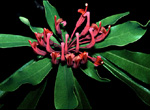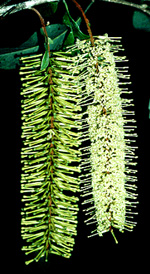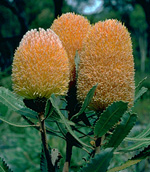 |
This is a typically Southern Hemisphere family, found mainly in Australia, South Africa and South America (with a few genera north of the equator in China and India). In Australia it is one of our most characteristic families, providing important genera such as Banksia, Grevillea and Hakea. Many genera are restricted to rainforests, especially in north-east Queensland, while many others are characteristic and often dominant in Mediterranean-climate heathlands on poor sandy soils, especially in south-western Western Australia. Some species of Proteaceae may be found almost anywhere in Australia except where soils are salty or heavy and nutrient-rich.
Characteristic features of the family Proteaceae in Australia include: - shrubs or trees with alternate, opposite or false-whorled leaves which may be simple or deeply divided and are usually tough and leathery
- flowers without a calyx and corolla, instead with one whorl of four, usually rather thick, white, yellow to red or green perianth parts, each usually with a single small stamen borne in a cup-like terminal limb
- ovary with one locule and style, the end of which is often enlarged into a specialised pollen-presenter
- fruit usually a woody, 2-valved follicle containing winged, flattened seeds, but sometimes a fleshy drupe or small, hard nut
Description
Evergreen or semi-deciduous trees, or shrubs, or rarely perennial
terrestrial herbs. Perennating by taproots or crowns. Vegetative reproduction
absent, or by rhizomes, stolons or root suckers. Stems unarmed or rarely
with prickles or spines arising from the stem surface; internodes terete,
costate, distinctly angular or rarely strongly flattened. Internal secretions
not obvious. Plants glabrous, or with simple, dendritic, clavate, capitate
or vesicular glandular or non-glandular, uniseriate hairs. Leaves alternate
and spiral, distichous, opposite, or in whorls of 3–7 or more, cauline
if herbs, petiolate or subsessile; pulvinae rarely present. Stipules and
stipellae absent. Lamina simple, once compound, bicompound or tricompound,
?palmate or imparipinnate, symmetric, pinnatifid or pinnatisect, palmatifid,
palmatisect, bipinnatifid, tripinnatifid, etc; lamina/segments filiform,
acicular, subulate, linear, lanceolate, ovate, elliptic, oblanceolate,
oblong, flabellate or orbicular; base cuneate, attenuate, rounded, cordate,
hastate or sagittate, lobed or auriculate or oblique; margins entire,
crenate, dentate or serrate, sinuate or spiny, ±flat, revolute,
recurved, involute or incurved; one-veined, or the venation pinnate or
palmate or parallel, with the midrib rarely inconspicuous, and the tertiary
venation reticulate or not; surfaces not punctate; leathery or hard and
spinose, rarely herbaceous. Domatia rarely present. All the flowers bisexual,
or bisexual flowers occurring together with male flowers. Inflorescences
terminal, axillary, cauliflorous, ramiflorous or rarely leaf opposed,
consisting of capitula, spikes, racemes, panicles, corymbs, umbels or
solitary flowers. Bracts present or absent. Pollination by insects, birds,
bats or small mammals. Flowers odourless, fragrant or malodorous, sessile
or stalked. Floral disc present or absent; nectaries present on the disc.
Perianth regular or irregular, of 1 whorl, with (3–) 4 segments which
are free or fused, or some are fused and others are free, and usually
petaloid, valvate in bud; corolla tubular or curved-tubular, white, cream,
yellow, orange, red, pink, magenta, purple, violet, blue, green, grey,
brown or black, without contrasting markings, or rarely with streaks,
spots, etc, leathery or rarely herbaceous. Fertile stamens (1–) 4, opposite
to and at least partly fused to the perianth segments, free of the ovary
and style, distinct from each other, all ±equal. Staminodes present
or absent. Staminal filaments sometimes distinctly flattened or absent.
Anthers basifixed, not versatile, opening inwards or rarely sideways by
longitudinal slits, 2- or 4-celled. Ovary superior, stalked or sessile.
Carpel 1; ovary with 1 locule. Style terminal, single and unbranched.
Ovules (1–) 2–30, stalked; placentation basal, apical or marginal. Fruit
simple or sometimes apparently composite, dry or fleshy, dehiscent or
indehiscent; a follicle, or septicidal capsule with dehiscence sometimes
explosive, or nut, or drupe; the perianth on the maturing fruit deciduous,
or dry and persistent. Disseminule macro-surface featureless, or with
a pappus or coma of hairs, with straight hairs, winged or awned; micro-surface
±smooth, spinulose, tuberculate, reticulate, alveolate or rugose,
cream, yellow, brown, grey or black, without contrasting markings, or
conspicuously patterned, glossy or dull. Seeds 1–20 per fruit. Aril absent.
Cotyledons 2 (–3 or more). Embryo straight, curved, sharply bent, round
or shapeless.
(Note: this description has been generated from the coded data compiled for the key. Any errors in the key data will be reflected in the descriptions.)
A treatment of the family Proteaceae has been published in:
Flora of Australia 16: 4-436, 17A and 17B.
Australian genera of Proteaceae (as recognised for the Flora of Australia)
Acidonia
Adenanthos
Agastachys
Athertonia
Austromuellera
Banksia
Bellendena
Bleasdalea
Buckinghamia
Cardwellia
Carnarvonia
Catalepidia
Cenarrhenes
Conospermum
Darlingia
Dryandra
Floydia
Franklandia
Grevillea
Hakea
Helicia
Hicksbeachia
Hollandaea
Isopogon
Lambertia
Lomatia
Macadamia
Musgravea
Neorites
Opisthiolepis
Oreocallis
Orites
Persoonia
Petrophile
Placospermum
Pycnonia
Sphalmium
Stenocarpus
Stirlingia
Strangea
Symphionema
Synaphea
Telopea
Triunia
Xylomelum

|
  |

Adenanthos barbigerus (flowers)
Photo: M.Fagg © ANBG

Alloxylon wickhamii (flowers)
Photo: G.Sankowski © Zodiac Publications

Athertonia diversifolia (flowers)
Photo: G.Sankowski © Zodiac Publications

Banksia burdettii (flowers)
Photo: R.Hotchkiss © ANBG

|
 |
|